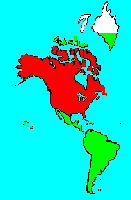SPECIES INFO
The Nebraska horse (Merychippus species) is the first horse to take a step forward in diet. This horse is considered the first horse to feed on prairie and grass like plants. This Miocene horse was a little over 3 feet high at the shoulder. This horse lived about 23 million years ago.
Remains of the Merychippus horse have been discovered in Oregon and dated to about 16 to 18 million years ago. Two additional species of Merychippus have been found in Oregon dated about 15 million years ago.Ancient horses were known as either Hyracotherium or Eohippus. Eohippus remains have been discovered in both Europe and North America. These were only about 1 foot high and weighed perhaps 30-40 pounds. Horses died out in Eurasia about 50 million years ago. However, horses survived in the New World where they continued to evolve. About 2-3 million years ago, modern horses were living in North America. Somewhere about that time, horses migrated back to Eurasia and Equus przewalskii survived in eastern Eurasia. Zebras were present in Africa. North American horses then became extinct about 8,000 years ago. The wild horses found in North America today are descendents of Eurasian breeds brought here by early Spanish explorers.
On page 130 of the book on Ice Age Mammals by Lange, there is an excellent family tree of the relationship between the various extinct horse genera.
On pages 399, 400, and 401 in the Encyclopedia of the Prehistoric World by Palmer there is a very nice spread of the various horses from the earliest known horse ancestor to the more modern forms.
Horse Family (Family Equidae) is now very rare in the wild, but many domestic breeds of horses survive and are used for farming, hunting, and other sporting activities. The zebra, wild ass, and the wild horse are found in this family.
There are eleven distinct species in this family when two of the domestic forms and one recently extinct form are counted as full species. The domestic donkey (Equus asinus) and the domestic horse (Equus caballus) have recently been raised to full species level. The zoologists have separated the domestic forms of many species from their wild counterparts with a unique scientific name.
To facilitate study of this family we have divided this family into three sections: Natural species, extinct species, and domesticated forms.
Horse Order (Order Perissodactyla) is a group of hoofed animals that walk primarily on their third toe which has modified to support their weight. Included in this order are the horses, zebras, rhinos, and tapirs.
Mammals (Class Mammalia), together with the birds, are among the youngest of the classes of animals. In species count, mammals number about fifty-one hundred, trailing reptiles (approximately fifty-five hundred), fish (approximately eighteen thousand), and birds (approximately eighty-six hundred).
There are three sub-types of mammals:
monotremes, the most primitive:
Develop in reptilian-like eggs and suckle milk emerging
(i.e., spiny anteater, duckbilled platypus)
marsupials
Newborn emerges very underdeveloped and continue to
mature in a pouch on its mother's abdomen (i.e., opossums,
koala, kangaroo)
placental
Embryo develops within the uterus of the female and is
dependent on a placenta for nutrition and waste removal
(i.e., humans, lions, monkeys)
About sixty-five million years ago, the Tertiary era produced thirty-five orders of mammals. Of this number, eighteen have survived to represent Earth's most diversified as well as its most highly developed classification of animals.
Extinction of mammals is fast becoming a serious issue. Duff and Lawson present a list of forty-one extinct species that reached extinction prior to 1800. These forty-one species are not acknowledged in the counts of the various families. Duff and Lawson also present a list of forty-six species including three gazelles, one zebra, one seal, one deer, and one wolf that have probably gone extinct since 1800. These forty-six species are included in the family counts. Science is adding about forty to fifty new species a year to the list. Many of these are the result of divisions of prior species; some are recent discoveries.
Mammals owe their survival to adaptive capabilities that include the ability to exploit whatever sources of food are available to them, as well as their ability to adjust to various climes. Food specialization influenced evolution to such a great extent that the teeth structure can and has been used to provide extensive information on the food needs and various lifestyles of extinct species.
Despite the vast diversity among mammals in terms of size, habitats and adaptations, they share without exception many characteristics such as:
a. body hair
b. mammary glands
c. certain skull characteristics
d. four limbs that permit speed
e. parallel not perpendicular limbs
f. compartmentalized internal organs
g. a four-chambered heart and pulmonary circulation
Backboned Animals (Phylum Chordata) are the most advanced group of animals on earth. These animals are characterized by having a spinal cord or backbone. Most members have a clearly defined brain that controls the organism through a spinal cord. Fish, amphibians, reptiles, birds, and mammals are in this phylum.
Currently, some taxonomists believe that the fish should be divided into two groups (sharks and regular fishes) and that there are some other primitive groups in the phylum such as hagfish or lampreys.
Animal Kingdom contains numerous organisms that feed on other animals or plants. Included in the animal kingdom are the lower marine invertebrates such as sponges and corals, the jointed legged animals such as insects and spiders, and the backboned animals such as fish, amphibians, reptiles, birds, and mammals.

